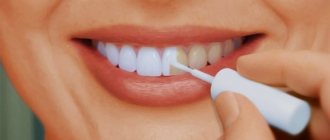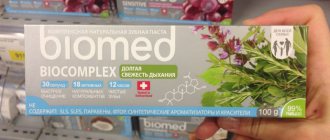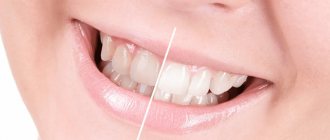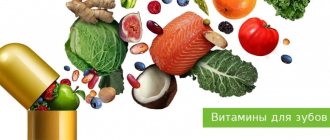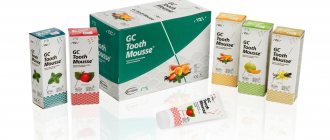Erosion of tooth enamel is a serious dental disease of a non-carious nature, manifested in the gradual abrasion of dental tissue. The disease can appear not only in adults, but also in children, although baby teeth are affected much less frequently. The difficulty in treating erosion lies in the fact that people suffering from erosive lesions of the teeth perceive it solely as an external defect, and are in no hurry to go to the dental office. Features of the disease, methods of its diagnosis, treatment and prevention will be discussed in detail in this article.
Prevention from destruction
- A balanced diet rich in vitamins and microelements: meat, fish, vegetables, fruits, cereals. It is advisable that all these products be present in the daily diet.
- Monitor your vitamin D level, as calcium absorption depends on it.
- You should spend more time outdoors and, if necessary, take vitamin D supplements. To replenish calcium reserves, eat more legumes, dairy products, and almonds.
- Give up bad habits: do not chew pencils and pens, do not open bottles with your teeth.
- Regularly undergo preventive examinations at the dentist. At the first signs of enamel destruction, consult a doctor immediately.
As practice shows, in many cases a damaged crown can be saved. The main thing is not to delay your visit to the dental clinic. Be healthy!
Causes of tooth decay
It happens that the enamel becomes fragile, cannot cope with the load and begins to crumble. Typically this process begins with the formation of small microcracks. Over time, they increase, leading to chips.
Tooth decay is influenced by many factors, both natural and mechanical.
- Poor hygiene. The accumulation of tartar and soft deposits create a favorable environment for the growth of bacteria. Those, in turn, release substances that destroy the enamel.
- Lack of vitamins and microelements that affect the formation of dental tissue, for example, vitamin D, calcium, phosphorus, etc.
- Abuse of sweets, alcohol, sour foods, seeds, smoking, sweet sodas. Simultaneous consumption of foods at different temperatures (ice cream and hot coffee).
- Bad habits: the habit of biting nails, a pen or pencil, opening a bottle with your teeth.
- Bruxism.
- Heredity.
- Diseases of the thyroid gland and endocrine system.
- Age-related changes.
- Pregnancy.
- Chronic diseases: arthritis, diabetes.
- Poor quality water.
Effective ways to restore tooth enamel
Tooth enamel can be restored, but only in a specialized clinic. This should be done by a professional. Today, two types of procedures are most often performed:
- fluoridation. Fluoride is an important element for enamel and its health. A varnish containing this substance is applied to the teeth. As a result, the enamel receives microelements, becomes stronger, calms down, and cracks become smaller. A similar procedure can be carried out once a year;
- remineralization. The principle here is the same, but the varnish contains more useful substances. Remineralization can be carried out twice a year. It has a cumulative effect. If you want the shell to be fully strengthened, it is important to complete the entire course.
Stages and features of treatment of tooth enamel erosion
Treatment of this disease is a rather long and complex process, the success of which often depends on the stage of its development. Based on this, appropriate treatment methods are selected.
Based on the intensity and depth of the lesion, the following stages of the disease are distinguished:
- Initial. Not visually detectable. The top layer is affected.
- Average. The disease becomes visually noticeable, there is a pronounced whitish tint, and all layers of enamel are susceptible to destruction.
- Heavy. The entire enamel is affected, the upper layer of dentin is involved.
It is important to understand that this pathology does not appear immediately, but gradually destroys the enamel and leads to serious consequences.
The disease can be identified by a number of symptoms:
- loss of the original shine of the enamel;
- change in tooth color;
- tooth sensitivity, pain when exposed to hot/cold food. This is explained by the appearance of a cavity in the affected area, which reacts to thermal changes and causes a corresponding painful reaction;
- the contours of the teeth are unnaturally transparent in appearance.
If such symptoms occur, you should make an appointment with the dentist.
What are the dangers of sweets?
Almost all sweet products: sugar, soda and syrups, jam, confectionery, sweet fruits (bananas, strawberries) are classified as simple carbohydrates. Such foods are broken down very quickly in the body and increase the amount of glucose in the blood, adding energy. This is effective before sports. When energy is not wasted, it is deposited in the form of fat reserves.
To break down and absorb simple carbohydrates, the body needs B vitamins and calcium. Teeth become a source for quickly obtaining the necessary macronutrients.
If the diet does not have enough vitamins and calcium, and a person consumes sweets excessively, then the expended reserves of necessary substances do not have time to be restored. This is how the process of internal tooth decay occurs. During this process, the enamel becomes thinner and caries develops.
Therapeutic measures
Treatment of erosion consists of a combination of the following methods:
- Remineralizing. A set of measures that includes applying a drug with a high calcium content to the lesions. Usually 3-5 procedures are prescribed. To consolidate the positive effect, fluoride varnish is applied to the damaged surface.
- Physiotherapeutic treatment. Calcium electrophoresis, which promotes the restoration of tooth tissue.
- Restoration. In case of severe tooth damage, the dentist recommends the use of veneers and crowns to hide the cosmetic defect and protect the tooth from further destruction.
- General therapy. Medications, vitamin therapy, and enrichment of the body with essential microelements are prescribed.
- Tooth polishing and whitening. Polishing is carried out using a special paste or powder, and bleaching and covering the eroded areas with fluorine-containing varnish will help restore the former whiteness.
Visible changes indicate the effectiveness of the treatment. The lesions begin to lighten and decrease in size.
Prevention
To prevent the formation of erosive lesions, the following preventive measures must be taken:
- reduce consumption of foods/drinks containing large amounts of acids;
- brush your teeth with a paste enriched with fluoride and calcium;
- avoid drinking too hot/cold drinks;
- After each meal, normalize the acid balance, or use sugar-free chewing gum;
- follow the rules for brushing your teeth: start from the back surface, spend at least 2 minutes brushing your teeth, and do not put too much pressure on the brush;
- When purchasing, give preference to brushes that have medium-hard bristles;
- if it is not possible to brush your teeth after each meal, then it is advisable to rinse your mouth with water at room temperature;
- drink acidic drinks through a straw;
- after a diet that consisted of acid-containing foods, it is better to refrain from brushing your teeth for one to two hours;
- For preventive purposes, visit the dentist’s office once every six months.
Following these simple rules will help reduce the risk of developing such an insidious disease as tooth enamel erosion.
How to minimize harm from sweets
The best option is to completely give up sweets. But for most adults, and especially for children, this option is unacceptable. According to statistics, there are very few people who are absolutely indifferent to sweets.
There are some recommendations for proper consumption of sweets, following which helps reduce the negative impact of sweets on teeth.
- The right treats . Experts recommend eating soft, but not sticky treats. For example, instead of toffees and marshmallows, it is better to choose cream cakes. They do not stick to tooth enamel and are easily removed after a couple of sips of drink.
- Sweets after meals . This rule is often voiced by parents to their children. After all, by eating sweets, you can “kill” your appetite. Dentists state this rule a little differently. During a meal (eating soup or side dish), a process of abundant saliva production occurs in the oral cavity. It is in this environment that sweets should be placed in order to neutralize organic acid as much as possible.
- Diet . Eating sweets should not be spread out over the whole day. It is recommended to eat the entire portion at one time. Constant snacking on sweets, cookies and chocolate regularly feeds bacteria. Such eating of sweets can lead to rapid destruction of enamel and the development of caries.
- Maintaining hygiene . From early childhood, you need to teach your child to brush their teeth. To reduce the negative impact of sweets on your teeth, you need to rinse your mouth after eating it. If this is not possible, then rinsing can be replaced by short-term use of chewing gum.
Natural pests
Not only sucrose, which is part of chocolate and sweets, but also fructose, which is found in some fruits and berries, has a harmful effect on tooth enamel.
Dentists recommend minimizing the consumption of the following treats:
- Dried fruits . Sweet prunes and raisins contain a large amount of fructose. This substance affects tooth enamel in almost the same way as sucrose. Dried fruits have an inherent viscosity, not unlike toffees. This means that they can also get clogged between the teeth and remain in the oral cavity for a long time.
- Candied fruits . Pieces of dried mango, kiwi and pineapple attract attention with their “naturalness”. However, candied fruits are sprinkled with sugar and sometimes tinted with dyes, which makes them little different from ordinary sweets.
- Sour fruits . Citrus fruits (oranges, lemons) cause significant damage to teeth. They contain a large amount of fruit acids, which can corrode enamel in the same way as candy.
Prevention of acid erosion
All diseases - including acid erosion of enamel - can be avoided if you visit the dentist every six months to a year for a routine examination. A competent specialist is able to diagnose non-carious dental diseases in the early stages and prescribe preventive measures.
Prevention of acid erosion
To do this, the doctor will diagnose erosive tooth wear, collect a life history and ask you about possible causative factors. You need to understand that there is no special device for assessing acid erosion. These defects can only be detected by a dentist during an examination.
Erosion that is not detected in the early stages later turns into a real problem. If you ignore early symptoms and do not consult a doctor, you may end up needing a serious comprehensive restoration of damaged teeth with restoration of bite height. This includes professional oral hygiene, often treatment of dental canals, strengthening them with pin structures and total prosthetics. This is an expensive and quite long rehabilitation that can be avoided with timely prevention.
What harms your teeth?
HomeAbout Dentco Medical Center and DentistryPublicationsArticles on dentistryWhat harms teeth?
In addition to the data we receive at birth, external factors also influence dental health, such as the foods we eat. So what foods threaten dental health?
If your diet constantly contains foods and dishes that are harmful to your teeth, their negative effects will sooner or later accumulate and will inevitably lead to oral diseases.
Let's look at several ways to damage tooth enamel:
Mechanical injuries. Tooth enamel is strong, but it has a limit of hardness: if something hard comes across a tooth (bone, shell, etc.), then a microcrack may appear on the enamel. It leads to the formation of caries and subsequently to significant tooth destruction.
Aggressive food components. A whole range of products - from fruits to fast food with the addition of flavoring additives and flavor enhancers - contain components that cause tooth enamel to become thinner; in some cases, chemical components of food can corrode the enamel. Organic acids. The result of the reaction between sugar and bacteria is organic acids. After eating sweet foods, that same organic acid is formed in the oral cavity, as a result we get the development of caries.
There is a whole list of foods that negatively affect teeth. It is best to limit these foods in your diet or take appropriate precautions.
Sweet. Scientists have proven that some sweets are more harmful than others. Ideally, the process of eating sweets should look like this - quick absorption, and then immediate rinsing of the mouth in order to avoid the formation of organic acids. Unfortunately, this tactic does not work with many types of sweets, so maximum damage is caused to the teeth.
Toffees (sticky sweets). They tend to get stuck in the interdental spaces and stick to the surfaces of the teeth. It turns out that if you ate toffee or some kind of toffee in the morning, it will act on your teeth until the evening. In this case, only an absolute refusal of this kind of sweets will help; try to replace them with soft, non-stick sweets that do not get stuck in your teeth.
Nuts, seeds. In fact, all solid foods are dangerous, since microcracks form when consumed. Such products are all types of nuts, all kinds of candies, hard crusts and seeds. Nuts are very important for the body, they contain many vitamins and nutrients. Therefore, it is impossible to completely stop using them. Advice: chop the nuts into small pieces, they can be added to food, cut off the hard rinds with a knife, take out the seeds, and you should completely avoid caramel and candies.
Kozinaki. This product causes particular harm to teeth, as it immediately affects several parameters. Firstly, kozinaki is sweet, secondly it is a product containing nuts, and thirdly it is very hard. By consuming kozinaki, you expose your teeth to the risk of mechanical injury and damage them due to the effects of sugar, which is sticky and remains in the oral cavity for a long time.
Sour fruits. Fruit acids thin out tooth enamel. Try to eat less “citrus fruits” (especially oranges, lemons, grapefruits); you should stop eating pomegranates. Juices from the above-mentioned fruits should be drunk through a straw and under no circumstances chew them together with the peel. After use, it is advisable to rinse your mouth with warm water.
How food affects the condition of our teeth
To significantly reduce the risk of developing caries and gum disease, you need to review your diet. There are products that not only do not contribute to dental health, but lead to a sharp deterioration in their condition. When answering the question about what foods you should not eat after brushing your teeth, you should immediately highlight acid-containing foods and sweets. The first category includes food products that destroy enamel and seriously harm hard tissues. Sugars, in turn, provoke a sharp growth of pathogenic microorganisms and the development of caries.
Eating unhealthy foods leads to tooth decay
Insufficient intake of vitamins and vital microelements into the body leads to a deterioration in the functioning of the immune system, and this, in turn, increases susceptibility to various kinds of pathological processes. For example, there are a number of studies confirming the close relationship between the condition of the oral cavity and systemic diseases, in particular diabetes and cardiovascular pathologies.
For dental health, it is important that the diet is varied, consisting mainly of healthy and wholesome foods, fruits, vegetables and cereals. But it is better to completely avoid spoiling treats or at least limit their consumption - the next section lists the most harmful of such treats.
